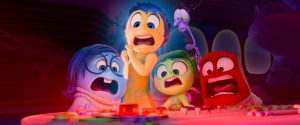Coming on to direct the sequel of an Oscar-winning animated feature is a daunting prospect, but luckily Kelsey Mann had producer Mark Nielsen to help with Inside Out 2. Having worked as an associate producer on the original Inside Out, Nielsen was thrilled when Pete Docter, who directed the original, suggested he work with Mann on the sequel.
Inside Out 2 returns to follow Riley Anderson (Kensington Tallman) and her emotional network during her teenage years. As she hits puberty, a crew of new emotions shows up, upsetting the balance Joy (Amy Poehler) has created in Riley’s mind. Mann did extensive research into how the brain is changed during puberty to create new settings and ideas for the sequel.
WHAT IS HAPPENING? – In Disney and Pixar’s “Inside Out 2,” Joy (voice of Amy Poehler), Sadness (voice of Phyllis Smith), Anger (voice of Lewis Black), Fear (voice of Tony Hale) and Disgust (voice of Liza Lapira) are awakened to an alarming reality: everything is changing now that Riley is 13. Directed by Kelsey Mann and produced by Mark Nielsen, “Inside Out 2” releases only in theaters Summer 2024. © 2023 Disney/Pixar. All Rights Reserved.
Disney/Pixar
DEADLINE: What was it about Inside Out that got you excited to make the sequel?
MARK NIELSEN: I was the associate producer on the first film nine years ago. Absolutely loved it, what a career highlight that was. Pete Docter’s films have been my favorites over the years… don’t tell the other directors. I had the chance to work with him on Up and on Monsters, Inc. and Inside Out, three out of four of his directorial projects, and this is a special one – exploring the world of emotions to personify them. What I haven’t had the chance to do yet was partner with Kelsey, which was an incredible honor.
KELSEY MANN: It’s been lovely. The other part too is that you’ve done this job before and I’m new at it. That was also another element that was really helpful for me, that somebody who has gone through it at this level versus us both doing it for the first time.
DEADLINE: Can you talk about your research process into what happens to your brain during puberty?
MANN: I remember doing a lot of reading about the change that goes on in our minds at that age, and I remember reading stuff like how neuron pathways are being torn down, new ones are being formed, and they’re not even quite connected yet, so I just got this idea of construction. I was like, cranes, construction crews, demolition… And then I was like, a wrecking ball needs to come through headquarters and then workers come in and just start tearing the place up. I came into this studio as a story artist and I know I’ve got something good when I’m jealous that somebody else is going to storyboard it.

BELIEF SYSTEM – In Disney and Pixar’s “Inside Out 2,” Riley’s Sense of Self is made up of all of her beliefs, each of which can be heard with the pluck of a string. Sadness (voice of Phyllis Smith) and Joy (voice of Amy Poehler) deliver key memories to this formative land. “Inside Out 2” releases only in theaters June 14, 2024. © 2024 Disney/Pixar. All Rights Reserved.
Disney/Pixar
The great thing with it, is it’s really good for a sequel. Early on, I made a whole list of sequels that I love and ones that I don’t like. Why do I like these and why do I not like these? These movies expanded the world and did new things, opened new doors, and those were just a copy paste, repeat, you know what I mean? Riley’s going through changes in her mind, so having that change is really good for a sequel, and that headquarters was going to go through a demolition to have it evolve was really good for a sequel. It’s a lot of really great emotional depth that we love at Pixar, but we can have a lot of fun with it and do a lot of jokes and introduce a lot of really fun new characters.
DEADLINE: We also get introduced to the new belief system, can you talk about that making more sense being added as she ages rather than being something that should have existed in the first film?
MANN: It’s about opening new doors in the world that you didn’t know were there, but were just around the corner. Those are my favorite sequels. So, I wanted to do that with this movie. I want to deal with memories, and the memories are a great example. You guys took something that we all know about, but you gave it a visual element. What do they look like? How do they work? What’s a core memory? You guys made all that and now it’s just part of our vocabulary. We wanted to expand that out. I remember talking early on about researching what happens to us as teenagers. A big part of what we do at that age is you start to develop who you are as an individual and you start to come up with your own opinions and along with that came what you believe.
Then the term belief system came up, and I’m like, ‘I want to go to the belief system. What does that look like?’ And it’s really exciting, but it’s also incredibly daunting. I had to go to Jason Deamer, our production designer, and go, “I want to go to the belief system. What does the belief look like? What would this be?” We had Ralph Eggleston, the production designer on the first film, helping us early on developing the right look. He explored what the beliefs could look like and we ended up going down the direction of… I knew I wanted them to be something you cared about, something that was emotional. How did I emotionally attach to this thing? Well, what about audio? What if we hear Riley’s voice say the things that she believes, not only about the world, but about herself? So, Riley says, “I’m kind, I’m a good friend.” If I hear her say that, I’m going to go, ‘Oh, I already care about it.’ What we want to do is make you care about something and then destroy it. Take it away, take it away. So, we all automatically felt something and we got the idea of a wavelength sound and somebody came up with the idea of plucking a guitar string and seeing a waveform. We could do a waveform that’s beautiful, and we can also do a waveform that’s very chaotic that will give you an emotional reaction based on the belief that you’re hearing.
DEADLINE: As male filmmakers, tell me about bringing a female perspective to the story.
MANN: We were some of the first people brought into the movie and we’re two men telling a story about a 13-year-old girl. We needed to adjust, so we immediately got Meg LeFauve as our writer. She was the first person we hired.
NIELSEN: It was me, you and Meg then at that point, but we wanted to be really intentional about building a team and building a leadership team that was going to bring that perspective. And we found such a great editor in Maurissa Horwitz, and we found some amazing other leadership in our character art director Keiko Murayama.
The story team was over half women, which is the first show that’s had that ratio. We tried to see as many women as we could get on the team to help really feed this. And then Riley’s crew, which is this group of teenage girls that we had as a trust all the way along that we could be running the film by and getting their thoughts on whether they felt they were being authentic with the story that we were telling and the characters that we were developing.
MANN: It’s true. And the other part that was really important too, is that I’ve got two kids, mark has a daughter and a son. I want my son to enjoy this movie just as much as my daughter and I want to be able to enjoy it too. So, I want to make sure that we’re being true to what it is to be a 13-year-old girl, but in a way that you don’t have to be, or have been, a 13-year-old girl in order to enjoy the movie.
NIELSEN: It’s really for everyone who’s ever felt feelings.
MANN: Which cuts out some people…
NIELSEN: It does.
MANN: If you don’t have any feelings, you might not like this movie.

